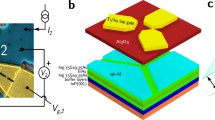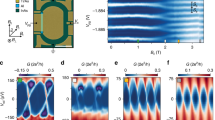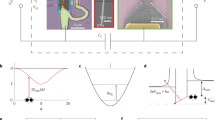Abstract
A well-known scheme for generating Majorana zero-energy modes is a heterojunction of s-wave superconductor and topological insulator that induces an equivalent two-dimensional p-wave superconductor at the interface. In this work, we construct a cylindrical system based on the heterojunction with the external magnetic field. We investigate the Aharonov–Bhom phase (A–B phase) of Majorana zero-energy state, find that the A–B phase between two Majorana zero-energy states located at the inner and outer boundaries of the ring system will interfere with each other. The intensity of interference fringes may change with A–B phase, which indicates that we can store the quantum information through the A–B phase and construct a single qubit A–B phase gate. We further explore the splitting of zero-bias conductance peak caused by the A–B phase and adjust the splitting energy by the A–B phase.
Graphic Abstract




Similar content being viewed by others
Data Availability Statement
This manuscript has no associated data or the data will not be deposited. [Author’s comment: This is a theoretical study and no experimental data.]
References
J. Alicea, Rep. Prog. Phys. 75, 076501 (2012). https://doi.org/10.1088/0034-4885/75/7/076501
M. Leijnse, K. Flensberg, Semicond. Sci. Technol. 27, 124003 (2012). https://doi.org/10.1088/0268-1242/27/12/124003
C. Beenakker, Annu. Rev. Conden. Ma. P. 4, 113 (2013). https://doi.org/10.1146/annurev-conmatphys-030212-184337
C. Nayak, S.H. Simon, A. Stern, M. Freedman, S. DasSarma, Rev. Mod. Phys. 80, 1083 (2008). https://doi.org/10.1103/revmodphys.80.1083
A. Kitaev, Ann. Phys. 303, 2 (2003). https://doi.org/10.1016/s0003-4916(02)00018-0
S. Zhu, L. Kong, L. Cao, H. Chen, M. Papaj, S. Du, Y. Xing, W. Liu, D. Wang, C. Shen, F. Yang, J. Schneeloch, R. Zhong, G. Gu, L. Fu, Y.-Y. Zhang, H. Ding, H.-J. Gao, Science 367, 189 (2019). https://doi.org/10.1126/science.aax0274
L. Fu, C.L. Kane, Phys. Rev. Lett. 100, 096407 (2008). https://doi.org/10.1103/physrevlett.100.096407
N. Read, D. Green, Phys. Rev. B 61, 10267 (2000). https://doi.org/10.1103/physrevb.61.10267
A. Das, Y. Ronen, Y. Most, Y. Oreg, M. Heiblum, H. Shtrikman, Nat. Phys. 8, 887 (2012). https://doi.org/10.1038/nphys2479
J.A. Jones, V. Vedral, A. Ekert, G. Castagnoli, Nature 403, 869 (2000). https://doi.org/10.1038/35002528
P. Solinas, P. Zanardi, N. Zanghì, F. Rossi, Phys. Rev. A. 67, 052309 (2003). https://doi.org/10.1103/physreva.67.052309
A. Shnirman, G. Schon, Z. Hermon, Phys. Rev. Lett. 79, 2371 (1997). https://doi.org/10.1103/physrevlett.79.2371
J.I. Cirac, P. Zoller, Phys. Rev. Lett. 74, 4091 (1995). https://doi.org/10.1103/physrevlett.74.4091
T. Sleator, H. Weinfurter, Phys. Rev. Lett. 74, 4087 (1995). https://doi.org/10.1103/physrevlett.74.4087
Z.-Z. Li, Solid State Theory (High Education Press, Beijing, 2002)
R.S. Akzyanov, A.L. Rakhmanov, A.V. Rozhkov, F. Nori, Phys. Rev. B 94, 125428 (2016). https://doi.org/10.1103/physrevb.94.125428
M. Cheng, R.M. Lutchyn, V. Galitski, S. DasSarma, Phys. Rev. Lett. 103, 107001 (2009). https://doi.org/10.1103/physrevlett.103.107001
S. DasSarma, J.D. Sau, T.D. Stanescu, Phys. Rev. B 86, 220506 (2012). https://doi.org/10.1103/physrevb.86.220506(R)
A. Teixeira, V. Carvalho-Santos, J. Fonseca, Phys. Lett. A 384, 126182 (2020). https://doi.org/10.1016/j.physleta.2019.126182
M.A. Nielsen, I.L. Chuang, Quantum Computation and Quantum Information (Cambridge University Press, Cambridge, 2009). https://doi.org/10.1017/cbo9780511976667
A. Barenco, D. Deutsch, A. Ekert, R. Jozsa, Phys. Rev. Lett. 74, 4083 (1995). https://doi.org/10.1103/physrevlett.74.4083
L.-M. Duan, J.I. Cirac, P. Zoller, Science 292, 1695 (2001). https://doi.org/10.1126/science.1058835
Acknowledgements
This work is supported in part by the Training Program of Major Research plan of the National Natural Science Foundation of China (Grant no. 92165105), the National Key R &D Program of China (Grant no. 2018YFA0305800, no. 2022YFA1402800), and the NSFC (Grant nos. 11974348, 11834014). It is also supported by the Fundamental Research Funds for the Central Universities and the Strategic Priority Research Program of CAS (Grant nos. XDB28000000 and XDB33000000), and CAS Project for Young Scientists in Basic ResearchGrant no. YSBR-057.
Author information
Authors and Affiliations
Contributions
All authors contributed to the study conception and design. Material preparation, data collection, and analysis were performed by ZL. The first draft of the manuscript was written by ZL and all authors commented on previous versions of the manuscript. All authors read and approved the final manuscript. This work has no associated date.
Corresponding authors
Appendix
Appendix
According to the BdG equation \(H \psi = E \psi =0\),
where \(u=v^{*}\). We first consider the second term of the equation:
Since the wave function needs to satisfy the particle–hole symmetry, we can write the angular part of u as \(e^{i(\frac{1}{2} + \frac{ e n \phi _0}{2 \pi \hbar })\theta }\), and its conjugate of v is \(e^{-i(\frac{1}{2} + \frac{ e n \phi _0}{2 \pi \hbar })\theta }\). Thus, the second term in Eq. (A1) can be reduced to
The first term in Eq. (A1) can also be written as an equation that only relates to the radial direction:
and we can thus obtain Eq. (3):
The formula contains both real and imaginary coefficients and due to particle–hole symmetry, we add the constant coefficient \(e^{i\frac{\pi }{4}}\) and \(e^{-i\frac{\pi }{4}}\) in the wave function:
Because the wave function of MZM is localized at the edge of the superconductor around the radius \(R_{\text {in}}\) and \(R_{\text {out}}\), we approximate the variable r in the coefficient as a constant R [1]:
the wave function of Majorana Eq. (4) can be obtained by solving Eq. (A7).
Rights and permissions
Springer Nature or its licensor (e.g. a society or other partner) holds exclusive rights to this article under a publishing agreement with the author(s) or other rightsholder(s); author self-archiving of the accepted manuscript version of this article is solely governed by the terms of such publishing agreement and applicable law.
About this article
Cite this article
Liu, Z., Wang, ZC. & Zhu, ZG. One-qubit Aharonov–Bhom phase gate constructed by Majorana zero-energy states. Eur. Phys. J. B 96, 90 (2023). https://doi.org/10.1140/epjb/s10051-023-00541-y
Received:
Accepted:
Published:
DOI: https://doi.org/10.1140/epjb/s10051-023-00541-y




